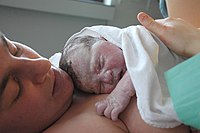
Photo from wikipedia
Vacuum-assisted vaginal delivery (VAVD) is considered a major risk factor for obstetric anal sphincter injuries (OASIS). However, it is difficult to estimate its true contribution to the occurrence of OASIS,… Click to show full abstract
Vacuum-assisted vaginal delivery (VAVD) is considered a major risk factor for obstetric anal sphincter injuries (OASIS). However, it is difficult to estimate its true contribution to the occurrence of OASIS, as its performance may be confounded by other determinants. Therefore, we aimed to evaluate the association of VAVD with OASIS among primiparous women compared to SVD. A retrospective cohort study including all primiparous women who vaginally delivered a cephalic singleton gestation during the years 2011 to 2020. As VAVDs were not performed before 34 gestational weeks, we capped the cohort at this gestational age. Women were allocated into two groups: VAVDs and spontaneous vaginal deliveries (SVD). We compared women with OASIS to those without and performed a multivariate analysis including factors that were found significant in the univariate analysis. We further divided the whole cohort into different subcategories. The primary outcome was the rate of OASIS in VAVD compared to SVD. Overall, 23,272 primiparous vaginal deliveries were available for evaluation. Of these, 3595 delivered by VAVD and 19,677 delivered spontaneously. OASIS occurred in 421 (1.8%) of the deliveries. OASIS were more common in VAVDs than in SVDs [83 (2.3%) vs. 338 (1.7%), respectively, OR (95% CI) 1.35 (1.06–1.72), p = 0.01]. After multivariate regression analysis, OASIS were not found to be independently associated with the mode of delivery [aOR 1.21 (95% CI) 0.88–1.68, P = 0.23]. In a categorical analysis of OASIS rates by risk factors and mode of delivery, VAVD was not associated with an increase in OASIS among women giving birth to neonates weighing > 3500 g compared to SVD [OR (95% CI) 1.02 (0.65–1.62), P = 0.90]. Among primiparous women VAVD did not increase the risk of OASIS compared to SVD.
Journal Title: International Urogynecology Journal
Year Published: 2020
Link to full text (if available)
Share on Social Media: Sign Up to like & get
recommendations!